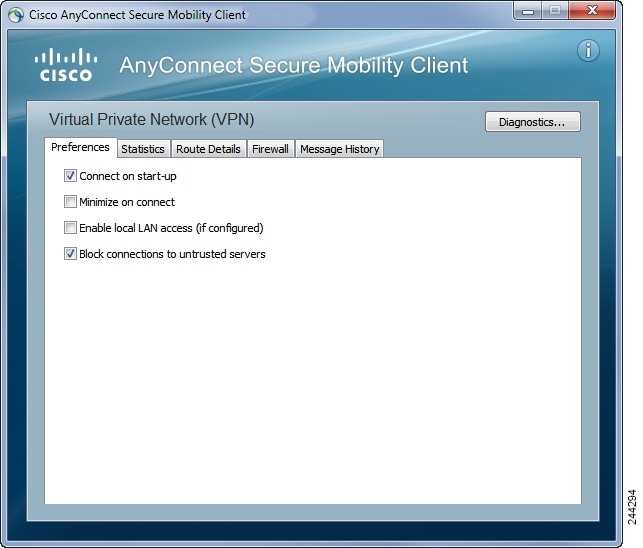
Most of our e-journals, databases, and electronic reserve materials are restricted so that only current UC San Diego faculty, staff, and students can use them off campus. Eligible users desiring off-campus access must configure their electronic devices to use a Virtual Private Network (VPN).
VPN AnyConnect (Client-based)
Install AnyConnect ICS+ from the Play Store.Note: If you are currently using AnyConnect for another VPN, you do not need to reinstall the application.You only need to. Dec 18, 2020 To sum up, you can fix Cisco AnyConnect if the VPN failed to load preferences by reinstalling the application, deleting its folder, or changing the security settings. However, if you’re interested in a great alternative to Cisco AnyConnect, consider using Perimeter 81.
This document describes how to set up a Adaptive Security Appliance(ASA) 8.0.2 to perform SSL VPN on a stick with Cisco AnyConnect VPN client. This setup applies to a specific case where the ASA does not allow split tunneling, and users connect directly to the ASA before they are permitted to go to the Internet.
VPN AnyConnect is the preferred way to access the Library's resources from off campus. To use VPN AnyConnect, you need to be able to install software on your device.
Download VPN AnyConnect
Important Note

Select 2-Step Secured - Allthruucsd from the 'Group' drop-down menu when authenticating.
Note: 2-Step login is required for faculty, staff, and student VPN connections.
Visit VPN EasyConnect (Web-based) if you cannot install software on your device.
Username & Password
A UC San Diego username and password is required to use VPN services. See Getting or Changing Your UC San Diego Password if you don't know your username or password.
Problems?
See our troubleshooting page for help.
Questions?
For help with connecting from off-campus using the VPN, contact the ITS Service Desk.
For more information about using library resources, Ask a Librarian.
Overview
Stanford's VPN allows you to connect to Stanford's network as if you were on campus, making access to restricted services possible. To connect to the VPN from your Windows computer you need to install the Cisco AnyConnect VPN client.
Two types of VPN are available:
- Default Stanford (split-tunnel). When using Stanford's VPN from home, we generally recommend using the Default Stanford split-tunnel VPN. This routes and encrypts all traffic going to Stanford sites and systems through the Stanford network as if you were on campus. All non-Stanford traffic proceeds to its destination directly.
- Full Traffic (non-split-tunnel). This encrypts all internet traffic from your computer but may inadvertently block you from using resources on your local network, such as a networked printer at home. If you are traveling or using wi-fi in an untrusted location like a coffee shop or hotel, you may wish to encrypt all of your internet traffic through the Full Traffic non-split-tunnel VPN to provide an additional layer of security.
You can select the type of VPN you want to use each time you connect to the Stanford Public VPN.
Install Anyconnect Vpn Client
Install the VPN client
- Download the Cisco AnyConnect VPN for Windows installer.
- Double-click the InstallAnyConnect.exe file.
- When a message saying the Cisco AnyConnect client has been installed, click OK.
Connect to the Stanford VPN
Setting Up Anyconnect Vpn On Asa 5505
- Launch the Cisco AnyConnect Secure Mobility Client client.
If you don't see Cisco AnyConnect Secure Mobility Client in the list of programs, navigate to Cisco > Cisco AnyConnect Secure Mobility Client. - When prompted for a VPN, enter su-vpn.stanford.edu and then click Connect.
- Enter the following information and then click OK:
- Group: select Default Stanford split- tunnel (non-Stanford traffic flows normally on an unencrypted internet connection) or Full Traffic non-split-tunnel (all internet traffic flows through the VPN connection)
- Username: your SUNet ID
- Password: your SUNet ID password
- Next, the prompt for two-step authentication displays. Enter a passcode or enter the number that corresponds to another option(in this example, enter 1 to authenticate using Duo Push to an iPad). Then click Continue.
- You may have to scroll down the list to see all of your options.
- If your only registered authentication method is printed list, hardware token, or Google Authenticator, the menu does not display. Enter a passcode in the Answer field and click Continue.
- Click Accept to connect to the Stanford Public VPN service.
- Once the VPN connection is established, a message displays in the lower-right corner of your screen, informing you that you are now connected to the VPN.
Disconnect from the Stanford VPN
Setup Anyconnect Vpn Windows 10
- In the notification area, click the Cisco AnyConnect icon if it is displayed. Otherwise, go to your list of programs and click Cisco AnyConnect Secure Mobility Client.
- At the prompt, click Disconnect.
